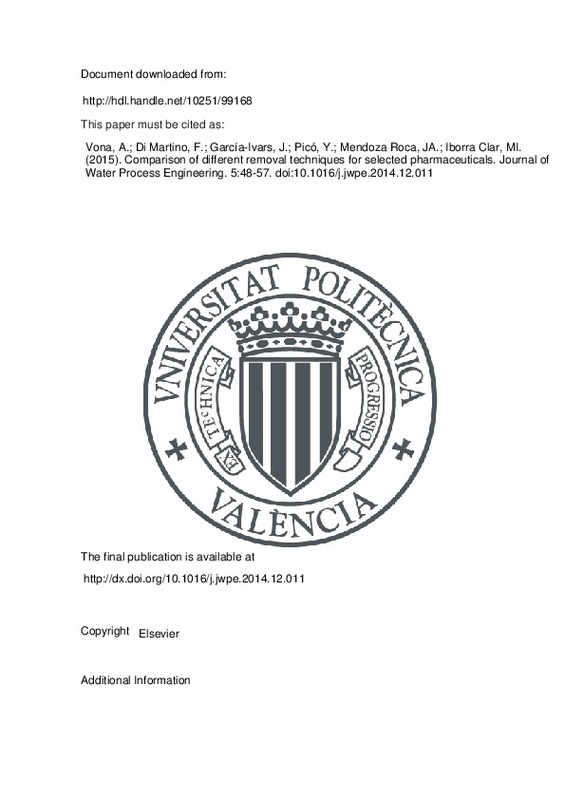JavaScript is disabled for your browser. Some features of this site may not work without it.
Buscar en RiuNet
Listar
Mi cuenta
Estadísticas
Ayuda RiuNet
Admin. UPV
Comparison of different removal techniques for selected pharmaceuticals
Mostrar el registro sencillo del ítem
Ficheros en el ítem
| dc.contributor.author | Vona, Andrea
|
es_ES |
| dc.contributor.author | Di Martino, Francesco
|
es_ES |
| dc.contributor.author | García-Ivars, Jorge
|
es_ES |
| dc.contributor.author | Picó, Yolanda
|
es_ES |
| dc.contributor.author | Mendoza Roca, José Antonio
|
es_ES |
| dc.contributor.author | Iborra Clar, María Isabel
|
es_ES |
| dc.date.accessioned | 2018-03-12T05:10:46Z | |
| dc.date.available | 2018-03-12T05:10:46Z | |
| dc.date.issued | 2015 | es_ES |
| dc.identifier.uri | http://hdl.handle.net/10251/99168 | |
| dc.description.abstract | [EN] Recently, there is an emergence of endocrine-disrupting compounds, pharmaceuticals, and personal care products (EDC/PPCPs) as important pollutants to remove from drinking water and reclaimed wastewater. In this work, the efficiency of removing pharmaceuticals (PCs) from model aqueous solutions and raw wastewater with ultrafiltration (UF), nanofiltration (NF), activated carbon adsorption (AC), biological methods (SBR) and oxidation with ClO2 was investigated. Some treatments have also been used as combined processes: UF + NF, UF +AC, SBR + ClO2. Ibuprofen, Acetaminophen, Diclofenac, Sulfamethoxazole, Clonazepam, and Diazepam were selected as model compounds. In order to evaluate their removal, PC solutions were also considered at several operating conditions (pH, conductivity, concentration, and temperature), andoptimal conditions were obtained. Experiments wereperformedatusual PCconcentrations in wastewaters: 1000 ng/L for Ibuprofen and Acetaminophen, 300 ng/L for Diclofenac, Sulfamethoxazole, Clonazepam, and Diazepam. Separation was evaluated by liquid chromatography¿mass spectroscopy. Results indicated that the removal efficiency depends on their Log KOW, which is intrinsically related to their hydrophobicity and then,to their adsorption onto the surface (UF, NF, andAC).Also, NF,AC, and combined processes (UF + NF, UF +AC) were the most suitable separation techniques to obtain high removal efficiencies for most of the PCs used, except for Acetaminophen (which showed great removal efficacy using SBR). UF presented low removal yields for all PCs tested. ClO2 treatment was more effective at high concentration (50 mg ClO2/L). Furthermore, results also showed that there are significant differences on the performance of the processes applied and which treatment is the most effective for each PC analyzed. © 2015 Elsevier Ltd. All rights reserved. | es_ES |
| dc.description.sponsorship | The authors of this work wish to gratefully acknowledge the financial support from the Spanish Ministry of Economy and Competitiveness through the project CTM2013-42342-P. | |
| dc.language | Inglés | es_ES |
| dc.publisher | Elsevier | es_ES |
| dc.relation.ispartof | Journal of Water Process Engineering | es_ES |
| dc.rights | Reconocimiento - No comercial - Sin obra derivada (by-nc-nd) | es_ES |
| dc.subject | Pharmaceutical compounds | es_ES |
| dc.subject | Membrane processes | es_ES |
| dc.subject | Activated carbon | es_ES |
| dc.subject | Environmental analysis | es_ES |
| dc.subject | Hybrid process | es_ES |
| dc.subject.classification | INGENIERIA QUIMICA | es_ES |
| dc.title | Comparison of different removal techniques for selected pharmaceuticals | es_ES |
| dc.type | Artículo | es_ES |
| dc.identifier.doi | 10.1016/j.jwpe.2014.12.011 | es_ES |
| dc.relation.projectID | info:eu-repo/grantAgreement/MINECO//CTM2013-42342-P/ES/EVALUACION DE LA VIABILIDAD TECNICA Y ECONOMICA PARA LA ELIMINACION DE COMPUESTOS FARMACOLOGICOS PERSISTENTES PRESENTES EN AGUAS RESIDUALES/ | es_ES |
| dc.rights.accessRights | Abierto | es_ES |
| dc.contributor.affiliation | Universitat Politècnica de València. Departamento de Ingeniería Química y Nuclear - Departament d'Enginyeria Química i Nuclear | es_ES |
| dc.description.bibliographicCitation | Vona, A.; Di Martino, F.; García-Ivars, J.; Picó, Y.; Mendoza Roca, JA.; Iborra Clar, MI. (2015). Comparison of different removal techniques for selected pharmaceuticals. Journal of Water Process Engineering. 5:48-57. https://doi.org/10.1016/j.jwpe.2014.12.011 | es_ES |
| dc.description.accrualMethod | S | es_ES |
| dc.relation.publisherversion | http://dx.doi.org/10.1016/j.jwpe.2014.12.011 | es_ES |
| dc.description.upvformatpinicio | 48 | es_ES |
| dc.description.upvformatpfin | 57 | es_ES |
| dc.type.version | info:eu-repo/semantics/publishedVersion | es_ES |
| dc.description.volume | 5 | es_ES |
| dc.identifier.eissn | 2214-7144 | es_ES |
| dc.relation.pasarela | S\279141 | es_ES |
| dc.contributor.funder | Ministerio de Economía, Industria y Competitividad | es_ES |







![[Cerrado]](/themes/UPV/images/candado.png)

